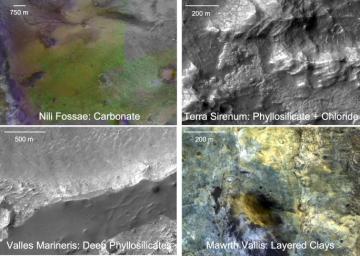
|
Four Types of Deposits From Wet Conditions on Early Mars
- Click the image above for a larger view
- Full-Res JPEG (2718 x 1936) (886.6 kB)
- Full-Res TIFF (2718 x 1936) (15.8 MB)
Caption:
Each of these four panels shows a close-up view of a different type of geological deposit formed with the involvement of water, based on observations by NASA's Mars Reconnaissance Orbiter. All four date from the earliest period of Martian history, called the Noachian Period.
The upper-left panel shows carbonates overlying clays in the Nili Fossae region of Mars. The view combines color-coded information from infrared spectral observations by the Compact Reconnaissance Imaging Spectrometer for Mars (CRISM) with an underlying black-and-white image from the High Resolution Imaging Science Experiment (HiRISE) camera. Beneath a rough-textured capping rock unit (purple) lie banded olivine-bearing layers (yellow), which in some places have been partially or wholly altered to carbonate (green).
The upper-right panel shows phyllosilicates and chlorides in the Terra Sirenum region, observed by CRISM and HiRISE. Medium-toned, finely fractured rocks containing chloride salts either underlie higher-standing, light-toned phyllosilicates or fill in low spots between them. Both sit on dark, eroded volcanic material.
The lower-left panel shows the upper portion of canyon wall in Coprates Chasma, observed by HiRISE and CRISM. The chasm rim cuts across the middle of the image. The wall slopes down to the top of the image and continues outside the region shown, exposing multiple phyllosilicate-bearing layers in a section of rock 7 kilometers (4 miles) thick. Two of the layers shown here are finely fractured aluminum clays that dominate the lower half of the image, underlain by thin beds of iron-magnesium clays at the top of the image. The dark material is a remnant of an overlying layer of basaltic sand that has been partly eroded away by the wind.
The lower-right panel shows phyllosilicates with vertically layered compositions in Mawrth Vallis, observed by HiRISE (presented in enhanced color) and CRISM. The brown-colored knob in the middle of the scene is a remnant of cap rock that overlies aluminum clays (blue-gray), which in turn overlie iron-magnesium clays (buff).
Background Info:
NASA's Jet Propulsion Laboratory, a division of the California Institute of Technology, Pasadena, manages the Mars Reconnaissance Orbiter for the NASA Science Mission Directorate, Washington. Lockheed Martin Space Systems, Denver, is the prime contractor for the project and built the spacecraft. The Johns Hopkins University Applied Physics Laboratory led the effort to build the CRISM instrument and operates CRISM in coordination with an international team of researchers from universities, government and the private sector. The University of Arizona, Tucson, operates the HiRISE camera, which was built by Ball Aerospace & Technologies Corp., Boulder, Colo.
Cataloging Keywords:
| Name | Value | Additional Values |
|---|---|---|
| Target | Mars | |
| System | ||
| Target Type | Planet | |
| Mission | Mars Reconnaissance Orbiter (MRO) | |
| Instrument Host | Mars Reconnaissance Orbiter | |
| Host Type | Orbiter | |
| Instrument | Compact Reconnaissance Imaging Spectrometer for Mars (CRISM) | |
| Detector | ||
| Extra Keywords | Color, Infrared, Volcano, Water | |
| Acquisition Date | ||
| Release Date | 2008-12-18 | |
| Date in Caption | ||
| Image Credit | NASA/JPL/JHUAPL/University of Arizona/Brown University | |
| Source | photojournal.jpl.nasa.gov/catalog/PIA11732 | |
| Identifier | PIA11732 | |
